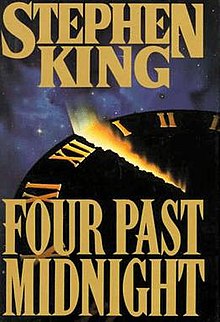
Stand by Me is a 1986 American coming-of-age film directed by Rob Reiner and based on Stephen King's 1982 novella The Body, with a title derived from Ben E. King's song. The film stars Wil Wheaton, River Phoenix, Corey Feldman, and Jerry O'Connell. In Stand by Me, four boys in 1959 Castle Rock, Oregon, go on a hike to find the dead body of a missing boy.

Secret Window is a 2004 American psychological thriller film starring Johnny Depp and John Turturro. It was written and directed by David Koepp, based on the novella Secret Window, Secret Garden by Stephen King, featuring a musical score by Philip Glass and Geoff Zanelli. The story appeared in King's 1990 collection Four Past Midnight. The film was released on March 12, 2004, by Columbia Pictures; it was a moderate box office success and received mixed reviews from critics.
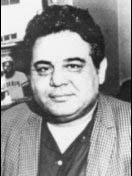
Samuel Joseph Byck was an American hijacker and attempted assassin. On February 22, 1974, he attempted to hijack a plane flying out of Baltimore/Washington International Airport, intending to crash into the White House in the hopes of killing President Richard Nixon. During the incident, Byck killed a policeman and a pilot but was shot by another policeman. Byck committed suicide.
Castle Rock is part of Stephen King's fictional Maine topography and provides the setting for a number of his novels, novellas, and short stories. Castle Rock appeared first in King's 1979 novel The Dead Zone and later in the novels It (1986), Doctor Sleep (2013), and Revival (2014) as well as the novella Elevation (2018). The town name is taken from the fictional mountain fort in William Golding's 1954 novel Lord of the Flies.

Needful Things is a 1991 horror novel by American author Stephen King. It is the first novel King wrote after his rehabilitation from drug and alcohol addiction. The story is about a shopkeeper who runs his business by exchanging goods for money and mysterious deeds performed by the customer. According to the cover, it is "The Last Castle Rock Story". However, the town later serves as the setting for the short story "It Grows on You" as well as King's 2018 novella Elevation. It was made into a film of the same name in 1993 which was directed by Fraser C. Heston.
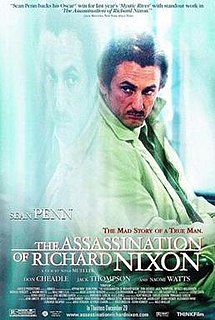
The Assassination of Richard Nixon is a 2004 American drama film directed by Niels Mueller and starring Sean Penn, Don Cheadle, Jack Thompson and Naomi Watts. It is based on the story of would-be assassin Samuel Byck, who plotted to kill Richard Nixon in 1974. It was screened in the Un Certain Regard section at the 2004 Cannes Film Festival. The last name of the main character was changed to Bicke.

Thomas Lee "Tom" Holland is an American screenwriter, actor, and filmmaker best known for his work in the horror film genre, penning the 1983 sequel to the classic Alfred Hitchcock film Psycho, directing the first entry in the long-running Child's Play franchise, and writing and directing the cult vampire film Fright Night. He also directed the Stephen King adaptations The Langoliers and Thinner. He is a two-time Saturn Award recipient.
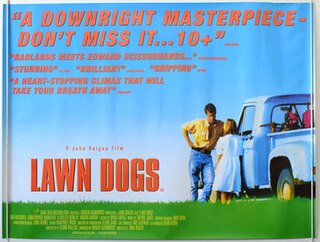
Lawn Dogs is a 1997 fantasy-drama film directed by John Duigan and starring Mischa Barton and Sam Rockwell. The film tells the story of a precocious young girl (Barton) from a gated community who befriends a landscape worker (Rockwell), and examines the societal repercussions of their friendship. Written by Naomi Wallace, the film was released by Rank Organisation, and was the company's last production.

Reunion is an American drama series that aired on FOX in late 2005. The series was intended to chronicle 20 years in the lives of a group of six high school friends from Bedford, New York, with each episode following one year in the lives of the six, beginning with their high school graduation year 1986. Each episode also featured scenes in the present where Detective Marjorino is investigating the brutal murder of one of the group during the night of their 20-year class reunion in 2006. The identity of the murder victim was not revealed until the fifth episode, "1990".

Sin City: A Dame to Kill For is a 2014 American action crime film and follow-up to the 2005 film Sin City. Directed by Robert Rodriguez and Frank Miller, the script is written by Miller and is primarily based on the second book in the Sin City series by Miller.

The Stand is a 1994 American television horror miniseries based on the 1978 novel of the same name by Stephen King. King also wrote the teleplay and has a minor role in the series. It was directed by Mick Garris, who previously directed the King adaptation Sleepwalkers (1992). In order to satisfy expectations from King fans and King himself, The Stand is a mostly faithful adaptation to the original book, with only minor changes to material that would otherwise have not met broadcast standards and practices, and in order to keep ABC content.
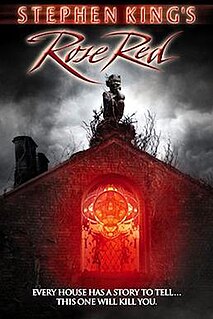
Rose Red is a 2002 American television miniseries scripted by horror novelist Stephen King, directed by Craig R. Baxley, and starring Nancy Travis, Matt Keeslar, Julian Sands, Kimberly J. Brown, David Dukes, Melanie Lynskey, Matt Ross, and Emily Deschanel. It was filmed in Lakewood, Washington. The plot focuses on a reputedly haunted mansion located in Seattle, Washington named Rose Red. Due to its long history of supernatural events and unexplained tragedies, the house is investigated by parapsychologist Dr. Joyce Reardon and a team of gifted psychics.

1408 is a 2007 American psychological horror film based on Stephen King's 1999 short story of the same name. It is directed by Mikael Håfström and stars John Cusack, Samuel L. Jackson, Mary McCormack, Tony Shalhoub, Len Cariou, Isiah Whitlock, Jr., and Jasmine Jessica Anthony. The film was released in the United States on June 22, 2007, although July 13 is mentioned as the release date on the website.

The Tommyknockers is a 1993 television miniseries based on the 1987 novel of the same name by Stephen King. Broadcast on ABC, it was directed by John Power, adapted by Lawrence D. Cohen and starred Marg Helgenberger and Jimmy Smits.

The Langoliers is a horror miniseries consisting of two episodes of 1½ hours each. It was directed and written by Tom Holland and based on the novella by Stephen King from the four-part anthology book Four past Midnight. The series was produced by Mitchell Galin and David R. Kappes, for Laurel Entertainment, Inc. The miniseries originally aired May 14–15, 1995 on the ABC network.

Dream House is a 2011 American psychological thriller film directed by Jim Sheridan from Universal Pictures and Morgan Creek Productions, starring Daniel Craig, Rachel Weisz, Naomi Watts, and Marton Csokas. It was released on September 30, 2011 in the United States and Canada and was panned by critics. It was released by Warner Bros. in international markets.
This is a list of winners of the Daytime Emmy Award for Outstanding Performer In An Animated Program. It recognizes a continuing or single voice-over performance in a series or a special. The performance can originate from a Children’s Animated, Special Class Animated Program

The Green Inferno is a 2013 American cannibal horror film directed by Eli Roth. The film was inspired by and is an homage to Italian cannibal films of the late 1970s and early '80s "cannibal boom", particularly Cannibal Holocaust (1980), which features a film-within-a-film titled The Green Inferno. The film follows a group of activists who are forced to fight for survival when they are captured by a cannibalistic tribe.
"Sacrifice" is the twenty-third and final episode of the paranormal drama television series Supernatural's season 8, and the 172nd overall. The episode was written by Jeremy Carver and directed by Phil Sgriccia. It was first broadcast on May 15, 2013 on The CW. In the episode, Sam makes the ultimate sacrifice in order to complete the trials to lock the demons from Earth with the last trial being Crowley himself. Meanwhile, Dean allies with Castiel and Metatron in order to finish the Heaven trials but they're ambushed by Naomi and her angels, finally finding out what will happen when the spells are finished.
